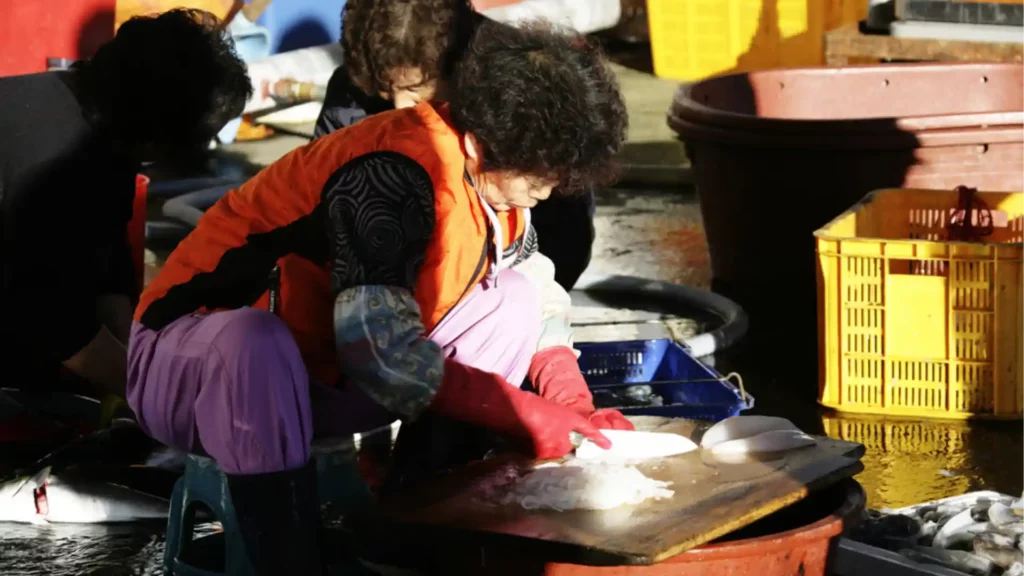The fishing sector in Japan is in dire need of workers
Mayumi Okada throws a thick, dripping rope into the Pacific Ocean with one final heave. Her husband Kuniaki leaves his cabin to look over the edge of their boat as a fresh afternoon wind creates frothy crests on the waves. He confirms that the most recent batch of oyster “spat” larvae is in place, ready to mature into the plump, highly prized bivalves associated with this region of northeastern Japan.
The pair gave up their normal jobs three years ago in order to start over in Tomari, a little coastal town located 500 kilometers (310 miles) north of Tokyo. The 54-year-old Kuniaki had always envisioned making a living by traveling the sea. Although Mayumi was encouraging, she also had personal goals including the sea.
Ofunato was the most hospitable site they looked at because he had always wanted to be a fisherman, according to 49-year-old Mayumi. “Fishing also piqued my interest, particularly raising oysters, scallops, and other shellfish.”
Off the coast of Iwate, one of the three prefectures decimated by a terrible tsunami thirteen years ago, they are getting ready to cultivate oysters today. Women prepare empty scallop shells in a quayside tent so the young oysters can grow into adulthood. However, Mayumi is more likely to be found in water than on land, in contrast to her female classmates.
The fishing sector in Japan is in dire need of workers. Similar to other conventional areas of the nation’s economy, it is aging and contracting in tandem with the overall populace. Japanese fishermen are getting close to 60 years old on average; in certain areas, they are above 70. Japan employed 700,000 seafaring laborers in 1961; however, by the early 1990s, that number had more than half, and by 2017, it had again halved.
Just 87,000 individuals are employed in the business as of the most recent five-year census, which was carried out in 2018, with women making up slightly over 11,000, or roughly 13% of the workforce.
“It seems like there aren’t many women who go out on boats, but at least it’s not zero,” Mayumi remarks. She will earn her full qualification next year after completing her studies at a fisheries academy. “We need everyone to pitch in because there are so few of us here.”
Kuniaki concurs.
Though attitudes are shifting, we have heard of corporations that declined to sell boats because they believed women would be working on them. But in an industry like fishing, the males won’t be able to accomplish it all by themselves if women aren’t participating.
As the workforce continues to dwindle, an increasing number of fisheries operators are looking to women for assistance. However, they face cultural opposition to women making a living at sea as well as a sector that is dominated by men at all levels.
A portion of that opposition stems from a folktale that says the sea goddess becomes “jealous” when women go on a fishing boat.
Koichi Sato, a fisherman for over thirty years living in the coastal district of Omoe further north, is dubious of revitalisation initiatives that push more women to do physically taxing and possibly hazardous labor at sea.
“A proverb states, ‘Women on land, men at sea.'” Sato remarks while operating a crane to extract sacks containing kombu seaweed from a storage tank.
“Working on a boat, dragging in the catch and storing it in storage, requires physical strength; without women, the local fishing business could not continue. And there are the lengthy workdays, which sometimes include working at night. What about seasickness, then?
Despite government initiatives, there are still few women employed in the fishing industry in Japan. This is because other industries such as farming and transportation make advantage of the country’s underutilized female talent pool.
Women interested in working in the fishing industry have been invited to recruitment events in Tokyo; but, according to a survey conducted in 2023, only around 60 of the 300 businesses looking to hire new employees stated they would hire women.
Kumi Soejima, a senior instructor at the National Fisheries University, states that there are tasks in the fisheries that people no longer believe can only be performed by males. Women now find it much easier thanks to mechanization and other advancements like the construction of restrooms.
A shift of perspective and a little creativity will suffice. The patriarchal culture that permeates the whole fishing sector, with older men at the top of the hierarchy, needs to change. The Japanese fishing sector needs to draw in more customers, especially women, if it is to thrive. The door needs to be ajar for them.
